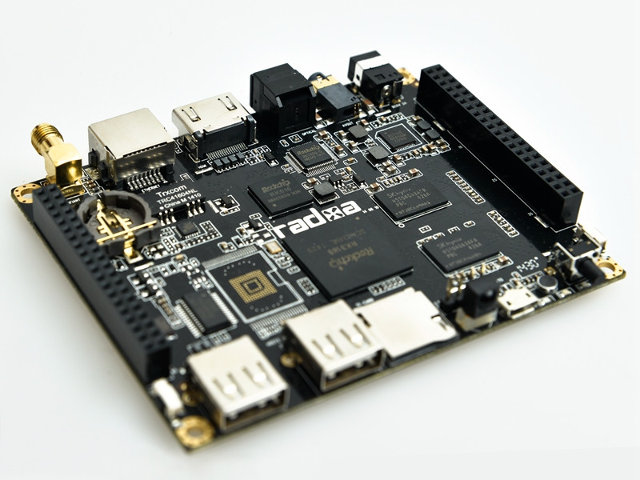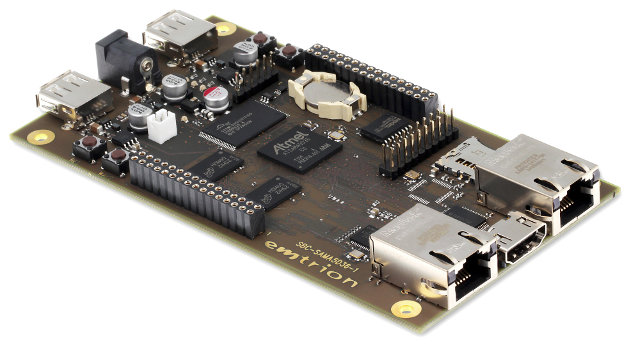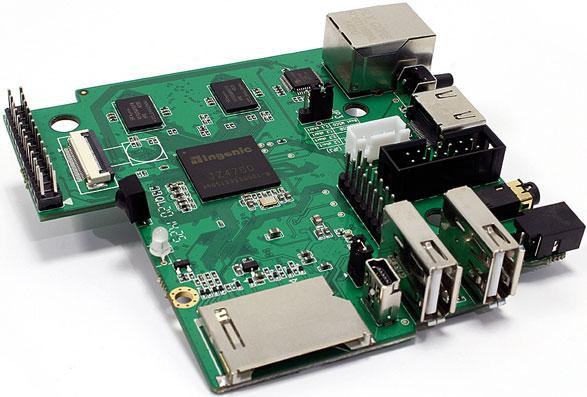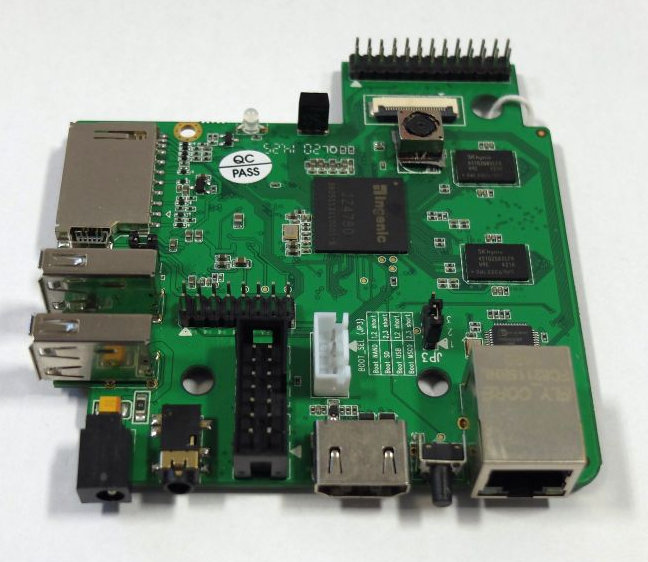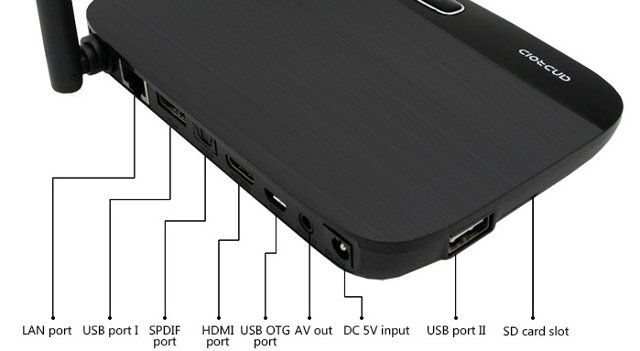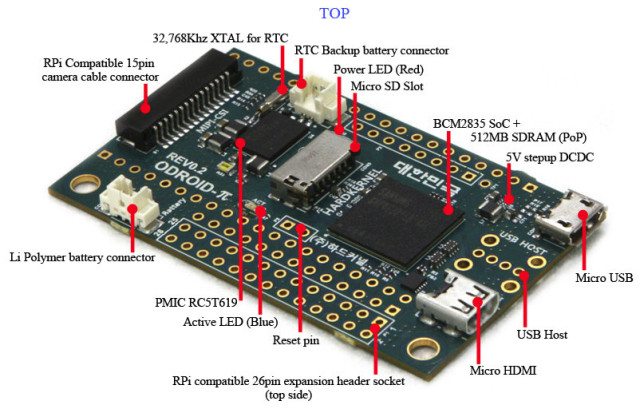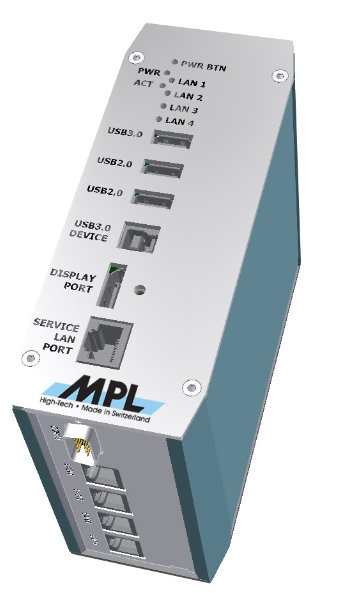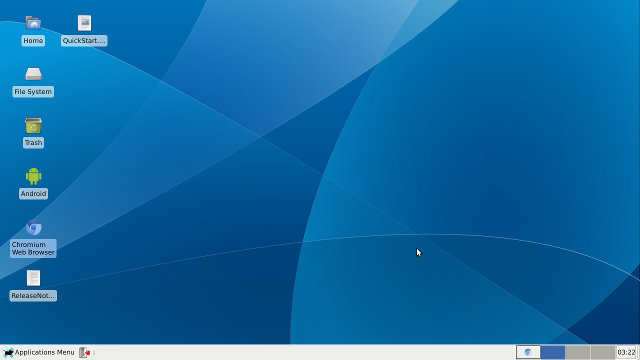You may have heard about Radxa Rock Lite development board before, so let’s clear up the different versions of the Radxa Rock first. There’s a total of four Radxa Rock models: Radxa Rock (2013) – The original version with 2GB RAM, 8GB NAND Flash, and Wi-Fi/Bluetooth Radxa Rock Lite (2013) – 1GB RAM, 4GB NAND Flash, and Wi-Fi only Radxa Rock Pro (2014) – An evolution of the Radxa Rock still with 2GB RAM, 8GB NAND flash, Wi-Fi/Bluetooth but adding LVDS and camera interfaces. Radxa Rock Lite (2014) – 1GB RAM, no NAND flash, and Wi-Fi only The fist two versions appear to have been phased out, as they are not listed for sale on Radxa Rock website, and today, I’ll write about Radxa Rock Lite (2014). Radxa Rock Lite (2014) specifications: SoC – Rockchip RK3188 ARM Cortex-A9 quad core @ 1.6Ghz + Mali-400 MP4 GPU System Memory – 1GB […]
Emtrion SBC-SAMA5D36 ARM Cortex A5 Linux Development Board Comes with Dual Ethernet, HDMI Output
A few months ago, I reviewed Atmel Xplained SAMA5D3 development board powered by SAMA5D36 Cortex A5 processor. The kit is supported by the Yocto Project, so I could build and run Poky distribution with a recent Linux kernel (it support mainline), it features Arduino compatible headers, and I found the board to be a nice platform for headless applications, or applications that require an LCD display. However, if you wanted to connect an HDMI display you’d be out of luck, unless you design your own LCD to HDMI add-on board. Emtrion SBC-SAMA5D36 could be an interesting alternative, as it features very similar specifications, but adds an HDMI output port. Emtrion SBC-SAMA5D36 specifications: MPU – Atmel SAMA5D36 single core Cortex-A5 @ 536 MHz System Memory – 256 MB RAM Storage – 512 MB NAND Flash, up to 16 MB NOR Flash, and micro SD Card socket Connectivity – 100Base-TX Ethernet, 10/100/1000Base-TX […]
MIPS Creator CI20 Development Board Formally Announced, Free to Selected Developers
Earlier this month, I discovered MIPS Creator CI20 development board based on Ingenic JZ4780 dual core MIPS processor thanks to one of my reader. Imagination Technologies has now launched the board, which will run Debian 7 first, soon support Android 4.4 and others Linux distributions, and the company places their MIPS board as a competitor to the popular ARM based boards such as the Raspberry Pi and BeagleBone Black. This is the first board part of Prpl initiative for open source Linux and Android software for the MIPS architecture. As a reminder, I’ll list the hardware specifications again: SoC – Ingenic JZ4780 dual core MIPS32 processor @ 1.2 GHz with Imagination PowerVR SGX540 GPU. 32kI + 32kD per core, 512K shared L2. System Memory – 1GB DDR3 Storage – 8GB NOR flash, 1x SD card slot, 1x SD card slot via expansion Video Output – HDMI up to 1080p Audio […]
MIPS Creator CI20 Development Board Powered by Ingenic JZ4780 SoC
There are plenty of ARM based development boards running Linux and Android, but with MIPS it’s a different story. Microchip does have some affordable development board powered by their MIPS MCUs, but these don’t have the hardware specs to run Linux based operating systems, and Ingenic Newton Platform for wearables can run Android and Linux, but it appears to be reversed to companies with virtual no documentation. There are some MIPS platform running OpenWRT on hardware such as routers or Wi-Fi boards, but these can’t be considered fully supported development boards. But Imagination Technologies is trying to make MIPS more relevant, first by launching Prpl developers’ community, and MIPS Creator CI20 development board powered by Ingenic JZ4780 dual core MIPS32 (Xburst) core processor with PowerVR SGX540 GPU should soon be available with complete documentation and source code. Let’s go through the hardware specifications first: SoC – Ingenic JZ4780 dual core […]
Dual Core VolksPC Android and Debian Mini PC Gets Crowdfunded
Last months, I tested VolksPC’s Android/Debian unified distribution on MK808 mini PC, which runs both operating systems at the same time, and allows you to switch instantaneously and seamlessly between the two. I was impressed by the performance and stability of the system, although there were still a few software bugs, as well as issues related to MK808 hardware (Wi-Fi disconnection), and possibly its 5V/1A power supply (system reboot when inserting SD card reader or flash drive). The company has now started a crowd-funding campaign on Indiegogo to manufacture dual core Android TV box with their unified distribution. VolksPC specifications: SoC – Rockchip RK3066 dual core ARM Cortex-A9 processor @ 1.4Ghz with Mali-400MP4 GPU System Memory – 1GB DDR3 Storage – 8 GB NAND Flash (for Android), 8GB MicroSD card (Debian Wheezy) Video Output – HDMI 1.3, AV jack Audio Output, HDMI, AV jack, and optical S/PDIF Connectivity – 10/100M […]
Hardkernel Unveils $30 Raspberry Pi Compatible Module with RTC, ADC, and LiPo Battery Support
Hardkernel is better know for its ODROID boards powered by Samsung Exynos SoC. So I was surprised to discover ODROID-W, “a miniature computing module which is fully compatible with all software available for the Raspberry-Pi”. Software compatible, really? Yes, because they used the same Broadcom BCM2835 SoC found in the Raspberry Pi, packaged it in a smaller form factor, while keeping HDMI, USB, and CSI interface, and expansion headers, and all that for $30, plus just $9 for shipping. Let’s go through ODROID-W specifications first: SoC – Broadcom BCM2835 ARM1176JZ-F processor @ 700 Mhz with VideoCore IV GPU System Memory – 512MB LPDDR2 (Samsung K4P4G324EB PoP) Storage – microSD slot + eMMC socket (bottom of the board) Video Output – micro HDMI (with NXP IP4791CZ12 protection IC) USB – micro USB connector, and USB host (not soldered) Expansion Headers: R-Pi compatible 26-pin expansion header (through holes) R-Pi compatible 15-pin CSI […]
MPL CEC10 Compact Embedded Computers Feature Bay Trail SoCs, 5 Gigabit Ports, Rugged Enclosures
MPL, a company specializing in industrial PCs based in Switzerland, has recently announced their CEC10 series “Compact Embedded Computer” featuring Intel Bay Trail-I E3800 processors, with 5 Gigabit Ethernet ports using RJ45, M12, or SFP connectors, and supporting industrial and extended temperature ranges, and as well as various rugged housings. Specifications for MPL CEC10: SoC – Intel Atom E3800 series single, dual, or quad processor @ up to 1.91GHz with Intel HD graphics. System Memory – up to 4GB DDR3L ECC-RAM Storage: mSATA interface Optional 2.5-inch SATA HDD/SSD Optional eMMC flash (soldered) Video Output- DisplayPort, optional eDP / VGA Connectivity – 5x gigabit Ethernet ports. RJ45 connectors by default, but the system also supports M12 connectors or SFP cages. USB – 1x USB 3.0 host port, 1x USB 3.0 device port, 2x USB 2.0 ports Serial – 1x RS-232 port, optional RS-232/422/485 or extra RS-232 port Expansion Slots: Mini-PCIe slot […]
Testing VolksPC’s MicroXwin Android & Debian Distribution in MK808 mini PC
Earlier this week, I wrote about VolksPC mini PC running Debian and Android simultaneously, and the developers decided to send me a unit for testing. The hardware I received is the popular MK808 mini PC based on Rockchip RK3066 with 1Gb RAM, and 8 GB RAM, but loaded with MicroXwin unified distribution. MicroXwin is an implementation of Windows X that’s not using a client/server protocol, for instead communicates directly with the drivers for better performance, especially on low-end hardware. I connected MK808 to my HDMI TV, added a USB hub to connect a USB keyboard as well as Mele Air Mouse, and powered up the device. The boot to Debian takes about 30 seconds, and 50 seconds for Android. As you boot it will enter in Debian with XFCE desktop environment, and you’ll notice two files, namely the Quick Start Guide and Release Notes that explain how to get started […]


